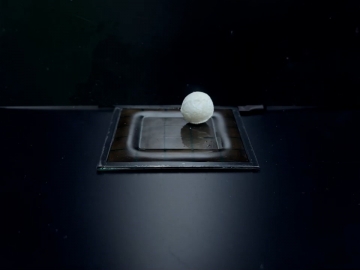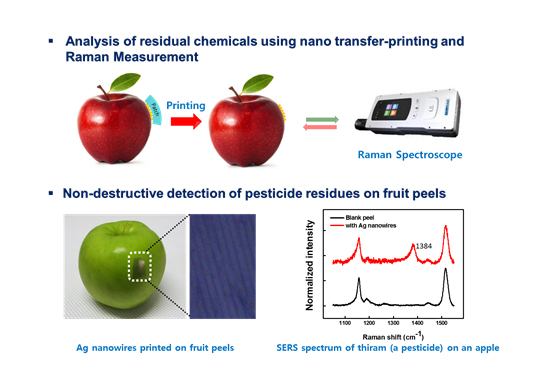KAIST
BREAKTHROUGHS
Research Webzine of the KAIST College of Engineering since 2014
Spring 2025 Vol. 24Ultrahigh-resolution 3D Nano-Printing Enables Detection of Trace-amount Substances
Ultrahigh-resolution 3D Nano-Printing Enables Detection of Trace-amount Substances
Sub-10nm nanotransfer printing technology has been developed to fabricate novel 3D nanostructures and devices such as a high-performance sensing device with single-molecule detection capability.
Article | Fall 2016
Printing was invented more than 5,000 years ago and has frequently been listed in the top 10 inventions that have changed the world. When people think of “printing,” they usually imagine paper and text, but printing can also be used for the high-volume manufacturing of useful electronic devices such as sensors and smart tags. Over the past decade, nanotransfer printing (nTP) has shown great promise in the area of nanomanufacturing due to its excellent scalability, cost-effectiveness, and three-dimensional (3D) fabrication capability.
Moreover, high-resolution nTP is an effective technology that, through a simple fabrication process, can enable the mass production of flexible devices, meta-materials, and other various futuristic products. However, thus far, the resolution of nTP has typically been limited to the 100 – 500 nm range because it is physically difficult to both replicate and transfer extremely small nanopatterns.
Prof. Yeon Sik Jung’s FunNano Team (Functional Nanotechnology Laboratory) has discovered that, unlike conventional silicone polymers used for nTP, certain polymers can reliably replicate ultrafine nanoscale patterns even smaller than 10 nm. Moreover, the principle of the so-called “molecular super-lubrication effect,” based on the controlled injection of organic solvent molecules, was developed and applied for facile and reliable transfer of functional nanostructures. These new findings and systematic investigations finally realized a universal nanofabrication method called “solvent-assisted nano-transfer printing (S-nTP)” technology, which enables the instantaneous printing of even sub-10nm structures on virtually any substrate without additional treatments.
As a demonstration of the outstanding feasibility of S-nTP, Prof. Jung’s lab presented non-destructive detection of residual pesticide molecules on a fruit surface by printing plasmonic gold nanowires on a fruit peel in combination with a spectroscopy technique called surface enhanced Raman scattering (SERS) analysis. In general, conventional chemical analysis tools require liquefaction of samples and multi-step chromatography processes, inevitably necessitating the destruction of samples as well as long processing time. SERS analyses based on metallic nanostructures with a signal-amplification function have emerged as a more rapid and accurate detection tool for trace-amount molecules. The new approach suggested by Prof. Jung’s group simplified the whole analysis procedure even more by transferring sensing nanostructures on to the surface of analysis targets, enabling a non-destructive, rapid, and accurate molecular analysis. This technique outperforms previous approaches in terms of convenience and analysis throughput.
Recently, the research team reported the 3D printing of plasmonic nanostructures using their S-nTP technique to integrate extremely dense and regular sensing-point arrays. The geometry of this 3D nanostructure is analogous to recent 3D memory device architectures designed for maximizing information storage density and improving device performance. The intriguing plasmonic nanostructure provides an enormous signal amplification capability, making it possible to achieve even single-molecule detection. Compared to commercial products based on 2D nanostructures, the new 3D nano-architecture produces ~ 100 times stronger sensing signal intensity.
SERS analyses can also be a potential solution for healthcare monitoring. The FunNano team developed a so-called “SERS contact lens” by printing plasmonic nanostructures on a curved lens surface, which is not possible using conventional nanofabrication tools. They confirmed that the smart contact lens can successfully detect glucose molecules in a highly diluted solution with a concentration level similar to that of human tears. This technique is targeting in situ monitoring of glucose levels in tears for diabetes patients and would potentially eliminate painful and time-consuming blood sampling. “The application area of this new idea can be widely extended to non-invasive biomedical diagnoses,” said Prof. Jung.
Articles on this research (entitled “High-resolution nanotransfer printing applicable to diverse surfaces via interface-targeted adhesion switching”, Nature Communications (2014) and “Three-dimensional Cross-point Plasmonic Nano-architectures Containing Dense and Regular Hot Spots for Surface-Enhanced Raman Spectroscopy Analysis,“ Advanced Materials (2016)) were published in scholarly journals. This invention was selected as one of the top 10 research accomplishments of KAIST for 2015, and the first author of the papers, Dr. Jae Won Jeong received the “Chung-Hyun Creativity Award” based on this achievement.
References:
J.W. Jeong, and Y.S. Jung et al., High-resolution nanotransfer printing applicable to diverse surfaces via interface-targeted adhesion switching. Nat. Comm. 5, 5387 (2014).
J.W. Jeong, and Y.S. Jung et al., Three-dimensional Cross-point Plasmonic Nano-architectures Containing Dense and Regular Hot Spots for Surface-Enhanced Raman Spectroscopy Analysis, Advanced Materials (2016).
Additional link for more information:
FunNano group website: http://funnano.kaist.ac.kr/
Video link: https://www.youtube.com/watch?v=x2NCyUr8VjA
Most Popular

When and why do graph neural networks become powerful?
Read more
Smart Warnings: LLM-enabled personalized driver assistance
Read more
Extending the lifespan of next-generation lithium metal batteries with water
Read more
Professor Ki-Uk Kyung’s research team develops soft shape-morphing actuator capable of rapid 3D transformations
Read more
Oxynizer: Non-electric oxygen generator for developing countries
Read more


